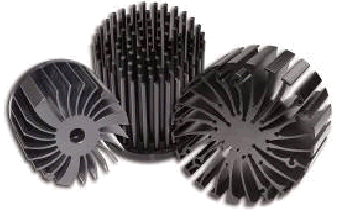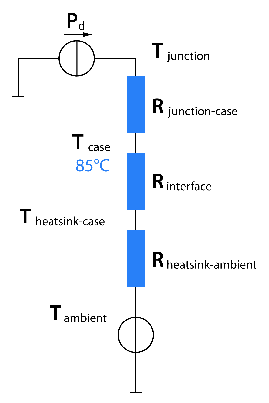
The Problem
Around 70% of the electrical energy of LEDs is transformed not into light output but into heat. In addition to choosing a suitable power supply, to fully guarantee the long life of LEDs it is also necessary to have sufficiently effective cooling. However, getting the heat sink calculation correct often proves to be a challenge. Many developers find it difficult to choose a suitable model from the wide range available on the market. Making the choice even harder is the fact that the heat sinks vary not only in material but also in design.
How is thermal resistance calculated?
Every application calls for a different heat sink. The calculations for these are based on physical fundamentals. The required information can be found in the datasheets for the LEDs for which a heat sink is being sought.
• For the thermal behaviour, we first need the nominal power, calculated by multiplying the forward current by the forward voltage. The manufacturers also provide the characteristic heat loss. With LEDs, this is around 70%, with approx. 30% efficiency remaining. By multiplying the power rating by 0.7, we find the heat loss.
Pe (nominal power) = lf (forward current) x Vf (forward voltage) Watt
Eff (Efficiency) = 30% -> i. e. 70% heat loss
Pd (heat loss) = Pe x 0.7 Watt
• Temperature conditions: dT signifies the difference in temperature between the temperature of the enclosure (Tc) and the assumed ambient temperature of the application (Ta). It is calculated as follows:
dT = Tc – Ta = x°C

• For the thermal resistance (Rth), we divide the value for temperature difference by the heat loss (Pd):
Rth (thermal resistance) = dT / Pd = x°C/W
• From this provisional thermal resistance, we then have to subtract the thermal resistance of the interface materials between the LED and the heat sink. From experience, this is usually between 0.1°C and 0.2°C.
Rth LED-Cooler = x°C/W – 0.2°C/W
Conclusion: The necessary thermal resistance of the heat sink must be less than or equal to this value. Now you can start looking for a suitable model.
Heat sinks at the click of a mouse:
• Tip: Anyone wanting to simplify their search for a suitable heat sink will find the support they need from producer MechaTronix: On the left hand side of MechaTronix' web site you can choose your suitable product application and a product finder will appear.
Under ''LED Brand'', users then only need to enter the LED brand of their choice and the calculated thermal resistance and, if necessary, some additional characteristics, e.g. the available diameter or the possible height. You can then compare suitable heat sinks.
Within their lighting range, Schukat electronic offers COB LEDs, heat sinks and power supplies with matching accessories. In this way, we support all users who want to assemble their components for a lighting solution with COBs themselves. Our many years of collaboration with well-known manufacturers makes this possible.












